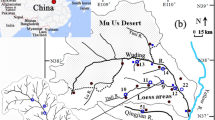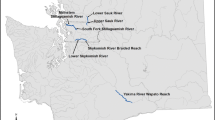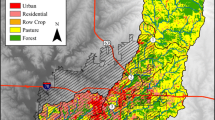Abstract
Extensive USGS data tables and detailed, 1 m2 LiDAR surveys are used to determine the optimal power n that relates discharge (Q) to stage (h*) above channel bottom (ho) at 39 gauging stations on small streams in the St. Louis, Missouri area, all of which have catchments of 0.6 to 220 km2. Four different methodologies are employed to determine both n and ho: (1) optimizing linearity in a plot of Q1/nvs. local stage (hL) using USGS field measurements at each site; (2) optimizing linearity in a plot of Q1/nvs. hL using USGS rating tables at each site; (3) a mathematical inverse method applied to the same USGS rating tables; (4) use of LiDAR data on channel geometry to determine the power dependences of channel area A and hydraulic radius H on h*, combined with the Manning and rational equations to predict n. Of these methods, only methods 2 and 3 compare favorably, and these values compare poorly with Method 1 based on field data, and with method 4 based on theoretical and empirical relationships. Because Method 4 is predictive, it provides a useful alternative to methods 1–3 that are based on USGS field measurements, which are heavily weighted toward low discharges. We conclude that the apparent values of n in the USGS rating tables are systematically too low for small streams.
Similar content being viewed by others
References Cited
Arundel, S. T., Archuleta, C.-A. M., Phillips, L. A., et al., 2015. 1-Meter Digital Elevation Model Specification. U.S. Geological Survey Techniques and Methods, Book 11, Chapter B7. 25. https://doi.org/10.3133/tm11B7
ASCE, 1988. The River des Peres: A St. Louis Landmark. http://sections.asce.org/stlouis/History/files/River%20des%20Peres%20%20A%20St.%20Louis%20Landmark.pdf
Chow, V. T., 1964. Handbook of Applied Hydrology. McGraw-Hill, New York
Criss, R. E., Lippmann, J. L., Criss, E. M., et al., 2007. Caves of St. Louis County, Missouri. Missouri Speleology, 45(1): 1–18
Criss, R. E., (2016. Statistics of Evolving Populations and Their Relevance to Flood Risk. Journal of Earth Science, 27(1): 2–8. https://doi.org/10.1007/s12583-015-0641-9
Criss, R. E., Luo, M. M., (2017. Increasing Risk and Uncertainty of Flooding in the Mississippi River Basin. Hydrological Processes, 31(6): 1283–1292. https://doi.org/10.1002/hyp.11097
Criss, R. E., 2018. Theoretical Link between Rainfall and Flood Magnitude. Hydrological Processes, 32(11): 1607–1615. https://doi.org/10.1002/hyp.11511
Criss, R. E., 2020. Dependence of Discharge, Channel Area, and Flow Velocity on River Stage and a Refutation of Manning’s Equation. In: Foulger, G. R., Jurdy, D. M., Stein, C. M., et al., eds., In the Footsteps of Warren B. Hamilton: New Ideas in Earth Science, Geological Society of America Special Paper
De Wiest, R. J. M., 1965. Geohydrology. John Wiley & Sons, New York FEMA, 2015. Flood Insurance Study, St. Louis County, Missouri. Volumes 1–4 Study No. 29889CV001A
Groetsch, C. W., 1999. Inverse Problems: Activities for Undergraduates. Cambridge University Press, Cambridge
Harrison, R. W., 1997. Bedrock Geologic Map of the St. Louis 30′×60′ Quadrangle, Missouri and Illinois. U.S. Geological Survey, Miscellaneous Investigations Series, Map I-2533
Hasenmueller, E. A., Criss, R. E., 2013. Multiple Sources of Boron in Urban Surface Waters and Groundwaters. Science of the Total Environment, 447: 235–247. https://doi.org/10.1016/j.scitotenv.2013.01.001
Lutzen, E. E., Rockaway, J. D. Jr., 1989. Engineering Geologic Map of St. Louis County, Missouri. Missouri Dept. of Natural Resources. OFM-89-256-EG
Madin, I., English, J. T., 2012. Interpolating Stage-Discharge Relationships Using Serial LiDAR along the Sandy River, Oregon. AGU Fall Meeting Abstracts, G23A-0898
MODNR, 2020. List of Impaired Waters (303d). Missouri Department of Natural Resources. https://dnr.mo.gov/env/wpp/waterquality/index.html
MSDIS, 2019. Missouri Spatial Data Information Service. (2019–11) [2020-10-9] http://msdis.missouri.edu/data
Nathanson, M., Kean, J. W., Grabs, T. J., et al., 2012. Modelling Rating Curves Using Remotely Sensed LiDAR Data. Hydrological Processes, 26(9): 1427–1434. https://doi.org/10.1002/hyp.9225
NWS, 2020. NWS Forecast Office St. Louis, MO. https://www.weather.gov/lsx/
National Oceanic and Atmospheric Administration (NOAA) Coastal Services Center, 2012. Lidar 101: An Introduction to Lidar Technology, Data, and Applications. Revised. NOAA Coastal Services Center, Charleston, SC
NOAA, 2017. Atlas 14 Point Precipitation Frequency Estimates: Missouri. [2020-6-1]. https://hdsc.nws.noaa.gov/hdsc/pfds/pfds_map_cont.html
Paul, J. D., Buytaert, W., Sah, N., 2020. A Technical Evaluation of LiDAR-Based Measurement of River Water Levels. Water Resources Research, 56(4): e2019WR026810. https://doi.org/10.1029/2019wr026810
Southard, R. E., 2010. Estimation of the Magnitude and Frequency of Floods in Urban Basins in Missouri. USGS Scientific Investigations Report 2010–5073. 27
Surdex, 2017. St. Louis LiDAR Acquisition and Processing Report; LiDAR Flight Log Report; USACE Contract G16PC00029
USGS, 1981. Guidelines for Determining Flood Flow Frequency. Inter-agency Advisory Committee on Water Data, Bulletin #17B of the Hydrology Subcommittee. U.S. Geological Survey, Office of Water Data Coordination, Reston, Virginia
USGS, 2020. USGS Current Water Data for Missouri. (2020–5). https://waterdata.usgs.gov/mo/nwis/rt
Vineyard, J. D., 1967. Physiography. In: Mineral and Water Resources of Missouri. Missouri Division of Geological Survey and Water Resources, 43: 13–15
Wahl, K. L., Thomas, W. O. Jr., Hirsch, R. M., 1995. Stream-Gaging Program of the US Geological Survey. US Geol. Survey Circular 1123, Reston, Virginia. http://water.usgs.gov/pubs/circ/circ1123
Wilson, D. A., 2009. Hurricane Ike and Impact of Localized Flooding in St. Louis County, Sept. 14, 2008. In: Criss, R. E., Kusky, T. M., eds., Finding the Balance between Floods, Flood Protection, and River Navigation. St. Louis University, Center for Environmental Sciences, St. Louis. 22–27
Acknowledgments
David L. Nelson is retired from Columbus Technologies and Services, Inc. and worked in support of the Jet Propulsion Laboratory, California Institute of Technology. This work was done as a private venture and not in the author’s former capacity as a contractor to JPL/Caltech. The authors thank the reviewers and the editors for their suggestions. The final publication is available at Springer via https://doi.org/10.1007/s12583-020-1089-0.
Author information
Authors and Affiliations
Corresponding author
Rights and permissions
About this article
Cite this article
Criss, R.E., Nelson, D.L. Discharge-Stage Relationship on Urban Streams Evaluated at USGS Gauging Stations, St. Louis, Missouri. J. Earth Sci. 31, 1133–1141 (2020). https://doi.org/10.1007/s12583-020-1089-0
Received:
Accepted:
Published:
Issue Date:
DOI: https://doi.org/10.1007/s12583-020-1089-0




